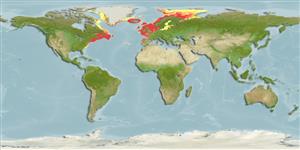| Native range | All suitable habitat | Point map | Year 2050 |

|
| This map was computer-generated and has not yet been reviewed. |
| Clupea harengus AquaMaps Data sources: GBIF OBIS |
Issue
The subspecies were not characterized well enough, that unless there is more evidence presented, Clupea harengus should be considered as one species with several known populations (S.Kullander, pers.comm. 07/09).